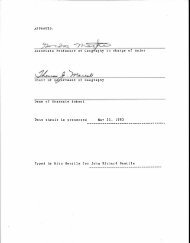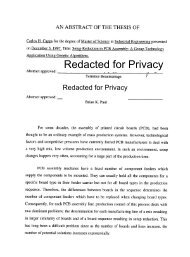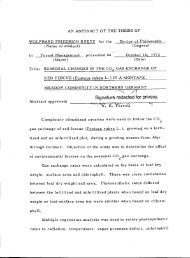In vitro anaerobic trinitrotoluene (TNT) degradation with rumen fluid ...
In vitro anaerobic trinitrotoluene (TNT) degradation with rumen fluid ...
In vitro anaerobic trinitrotoluene (TNT) degradation with rumen fluid ...
Create successful ePaper yourself
Turn your PDF publications into a flip-book with our unique Google optimized e-Paper software.
<strong>In</strong> Vitro Anaerobic Trinitrotoluene(<strong>TNT</strong>) Degradation <strong>with</strong> Rumen Fluid and<br />
An Isolate, G.8<br />
1.1 Background<br />
Chapter 1. <strong>In</strong>troduction<br />
Since World War II, 2,4,6-<strong>trinitrotoluene</strong> (<strong>TNT</strong>) has been widely used in the<br />
production of explosives because of its low boiling point, stability, low sensitivity to<br />
impact, and its relatively safe methods of manufacture. Since this development,<br />
manufacturing products and wastes containing <strong>TNT</strong> have contributed to contaminated<br />
environments (23). The contamination of over 1,100 military facilities potentially<br />
contaminated <strong>with</strong> munitions waste will require that greater than 1,000,000 cubic<br />
yards of contaminated soil be treated (2)<br />
Explosive wastes are also toxic to some aquatic organisms (9,27). Concerns<br />
about toxic health effects arise from evidence linking extensive occupational contact to<br />
<strong>TNT</strong> <strong>with</strong> increased incidence of aplastic anemia, liver damage, dermatitis, ocular<br />
disorders, and gastrointestinal distress. With respect to these concerns, initiatives<br />
undertaken to assess the content of existing waste disposal sites and to search for<br />
environmentally acceptable ways to remediate contaminated soils have been supported<br />
by military and other government agencies (23).<br />
The most practical approach to the remediation of explosives is currently soil<br />
incineration, but it can be a costly, energy-intensive process that destroys much of the<br />
soil, leaving ash as the primary residue <strong>with</strong> estimates approaching $800/ton (13).<br />
Chemical treatment requires the exercise of rigid controls to avoid the discharge of<br />
unreacted materials and is not practical in many situations. It is believed that the














